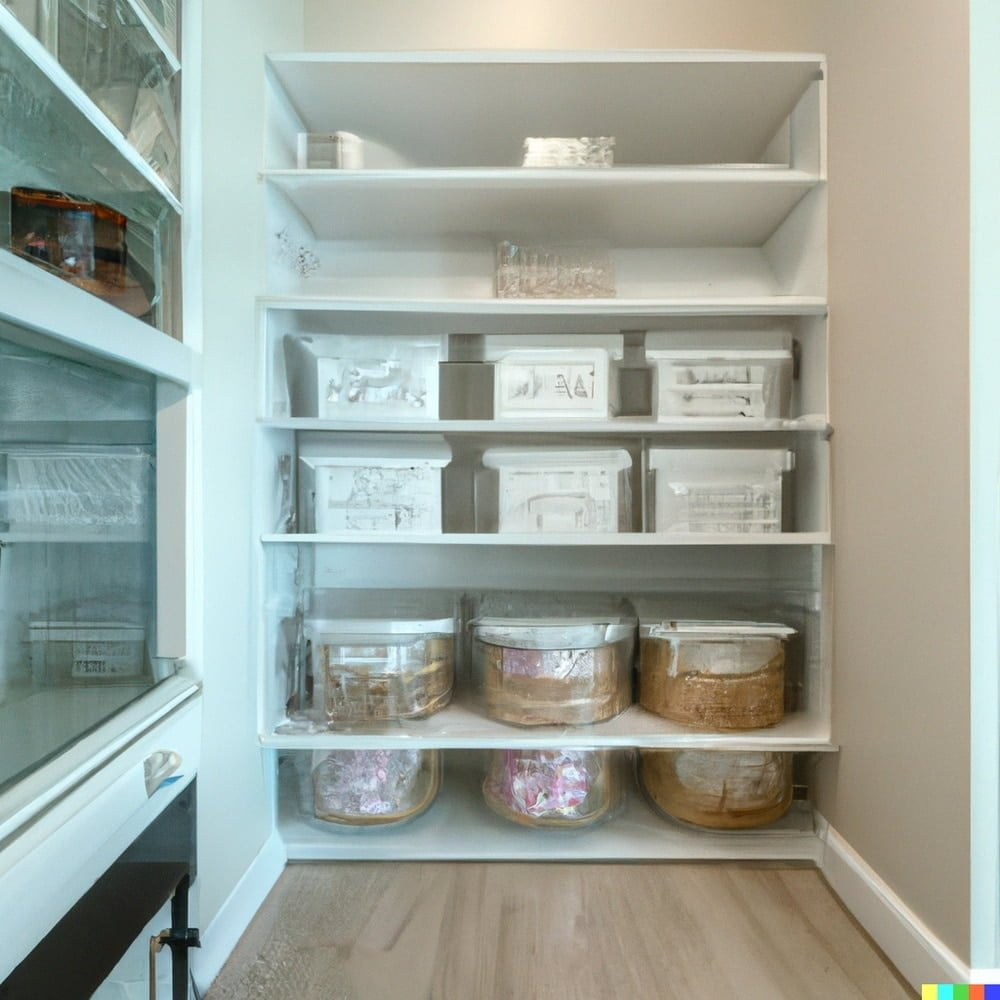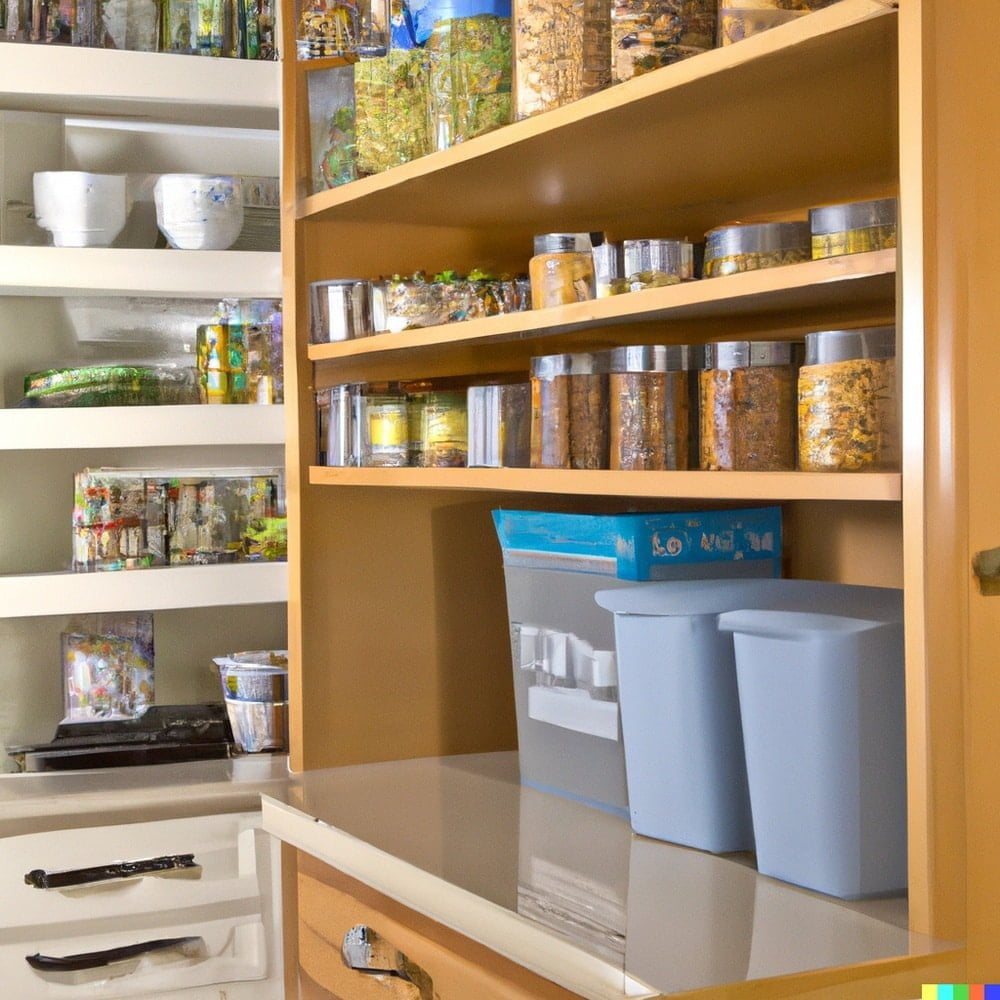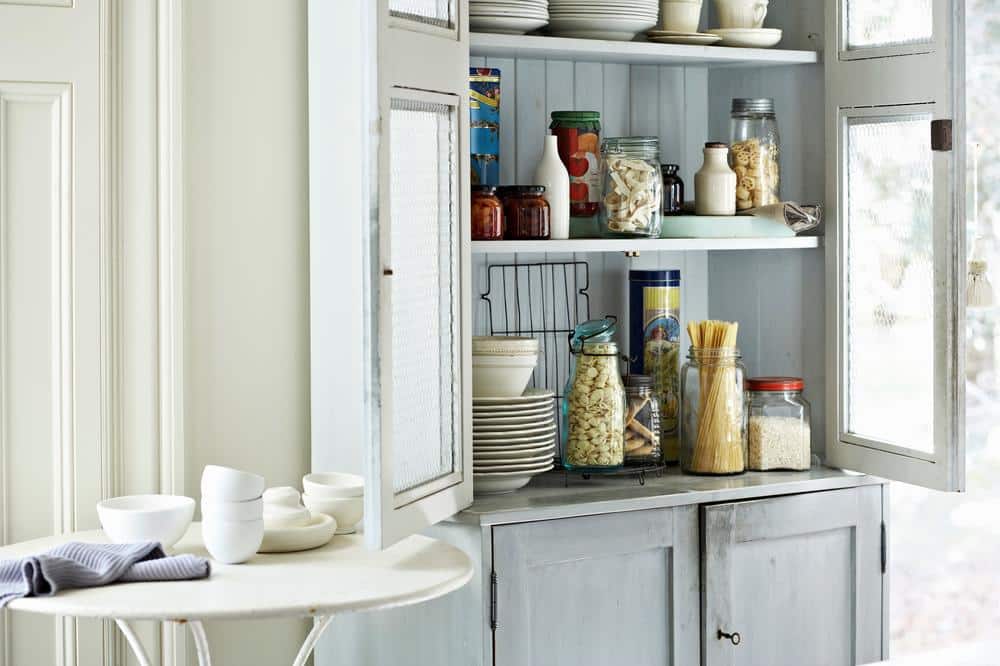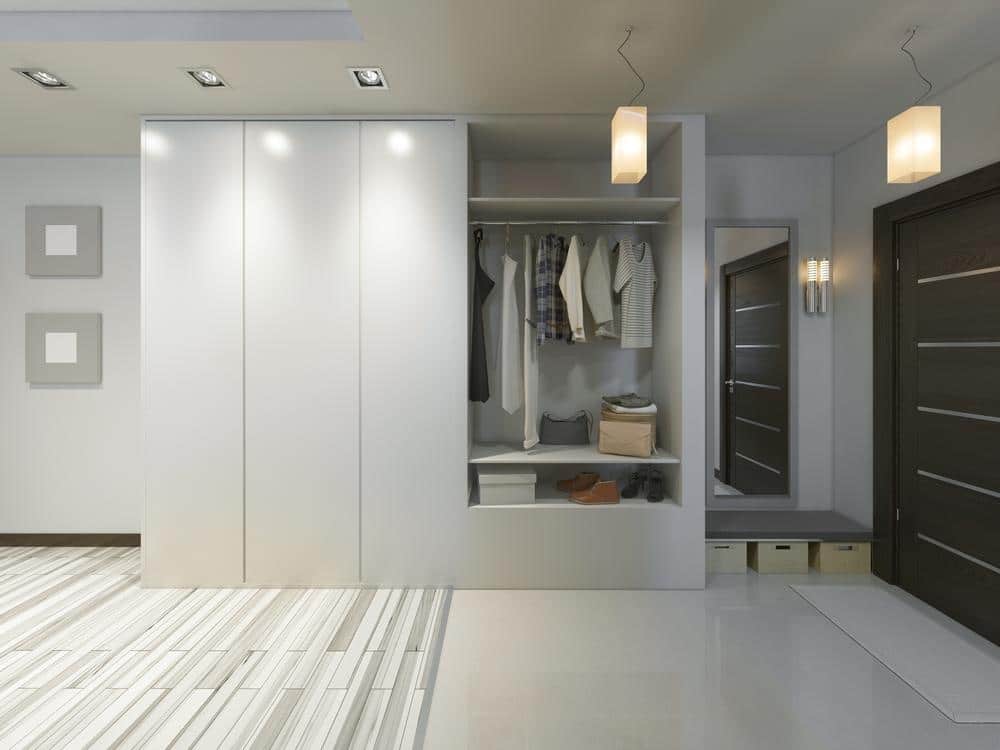Walk-in pantries make it easy to store food staples and prepare foods before cooking. A walk-in pantry is ideal if you enjoy cooking. The walk-in pantry depth is determined by the required aisle width, shelf depth, and width of the work counter if one is installed. Shelves should be at least 16 inches deep, and the work counter should be at least 18 inches deep. The minimum aisle width must be determined based on the number of people working in the pantry and whether or not handicap accessibility is required.

Basic Design Principles of Walk-in Pantry Depth
Table of Contents
- Basic Design Principles of Walk-in Pantry Depth
- Standard Pantry Sizes
- How Deep Should a Pantry Be?
- Small Walk-in Pantry Depth Dimensions
- Minimum Pantry Dimensions
- Size and Depth for a Walk-In Pantry and Adjustable Pantry Shelves
- Pantry Shelf Depth
- Decide How Big Your Pantry Should Be
- Conclusion on How Big Walk-In Pantries Should Be
- What dimensions are needed for a walk in pantry?
- How deep should walk in pantry shelves be?

Many factors determine the minimum depth of your pantry. The first is whether more than one person may use the pantry simultaneously. The second consideration is whether any individuals who use wheelchairs intend to use the pantry. The third factor is the shelf’s depth and the work counter’s width.
Slide-past and walk-past clearances for non-disabled people are 42 and 48 inches, respectively. Thirty-six inches is sufficient for a single ambulatory user. Add 16 inches for a minimum shelf width to get the minimum depth for your walk-in pantry. If you have enough room, you can add a countertop work area opposite the shelves; this is useful for sorting groceries and preparing food. The minimum depth equals the sum of the aisle width, shelf depth, and work counter width.
Standard Pantry Sizes

The common size of a standard pantry is 5 feet by 5 feet (U-shaped). The dimensions of these cabinets might vary since not all homeowners have the same kitchen size. The amount of storage that the homeowner prefers is also a factor. When choosing a pantry, a rectangular walk-in pantry is typically favored. The aisle size should always be at least 44 inches wide when deciding on a pantry. Moving the pantry around the kitchen with a minimum width of 3.7 feet (44 inches) is always advisable. A small-sized pantry with storage on one side must have a 60-inch-wide aisle, while a large-sized pantry must have a 76-inch-wide aisle.
How Deep Should a Pantry Be?

The 1-foot-deep pantry shelves should be enough for the food storage in your house. The depth of the pantry shelves should not exceed 1 foot to avoid burying things. You will have to purchase the buried items again if you do not see them clearly while building your pantry.
Small Walk-in Pantry Depth Dimensions

A small walk-in closet provides the perfect storage solution for your home’s limited space. The small walk-in pantry should be at least 5′ x 3′ in dimension. It can measure anywhere between 5 ‘x3” up to 10’.
Minimum Pantry Dimensions

For those interested in adhering strictly to ADA accessibility requirements–a minimum of 60″ clear walking distance applies when designing cabinets fitted specifically as accessible units within their home. When installing a walk-in pantry, the space between shelves and storage areas should be 36 inches wide to allow easy access for one person.
A width of 48 or more can accommodate two people who need to use this area at once in kitchens where there’s more than just yourself cooking on any given day. For those interested in adhering strictly to ADA accessibility requirements–a minimum of 60″ clear walking distance applies when designing cabinets fitted specifically as accessible units within their home.
The minimum dimensions for a shelf in your pantry are 14 inches deep and 64 to 76 inches wide. If you want wheelchair access, ensure the width is at least 88 inches long.
Size and Depth for a Walk-In Pantry and Adjustable Pantry Shelves
A walk-in pantry should have a minimum width of 48 inches and a maximum depth of 36 inches. This means that the walk-in pantry should not be wider than it is deep. In order to maximize the storage capacity of your walk-in pantry, you should use adjustable shelving units to fit in whatever space remains. For example, if your walk-in pantry is 24 inches deep, you might prefer to use shelves that are 12 inches deep. This will ensure that you have ample space for all of your items without taking up too much room in the pantry itself. Additionally, adjustable shelving allows you to customize the height and capacity of each shelf according to your specific needs.
When deciding on walk-in pantry depth, always remember the size of the items you plan to store. Narrow walk-in pantries are best for storing small items such as cans and boxes, while wider pantries may be better suited for larger kitchen appliances or bulky items. You can make the most of your walk-in pantry space with careful planning and thoughtful design. By taking careful measurements and considering your storage needs, you can create a walk-in pantry that fits all of your items without compromising on space.
Narrow Walk-In Pantry Dimensions
A walk-in pantry is an incredibly handy feature in any kitchen. It provides a great space for storing all of your dry goods and other items that may not fit on the shelves of a traditional pantry. When planning the design of your walk-in pantry, it’s important to consider the dimensions so you can make the most of the space. The walk-in pantry depth is especially important because it will determine how far back into the room you can place your items.
Narrow walk-in pantries typically have a depth of 24 inches or less, while a wider pantry may be as deep as 36 inches. Narrower depths are best for providing efficient storage while maximizing the amount of space in your kitchen. Narrow walk-in pantries should also have a minimum width of at least 48 inches to provide sufficient room for navigating and organizing your items. The height of the pantry should be determined by how much space you need to store all of your items, but is typically between 80-84 inches.
When planning a narrow walk-in pantry, make sure that the shelving, racks, and other storage solutions are designed to fit within the dimensions of the room. This will ensure that you can make the most of the space and maximize your storage capabilities. Narrow walk-in pantries are an excellent way to store food, cookware, and other kitchen items while maintaining a functional layout. With careful planning and design, you can create a narrow walk-in pantry that fits all of your needs.
Pantry Shelf Depth

The perfect pantry is one where you can easily access everything in it, and shelves that are too deep make finding items near the back difficult. The ideal depth for a shelf should be 14 inches, but if your reach comfortably isn’t more than 16″, then this maximum will work well with what’s available to store on them!
Maximizing your storage space is accessible by keeping the vertical distance between shelves as small and compact as possible. 16-18 inch tall shelves are ideal for holding large items, while general purpose ones should be 12 -14 inches high with a 6″ thickness to accommodate their widths (or eight if they’re going in an open area). Cans/spices can go up against each other without too much issue at just 5″.
Corner Walk-In Pantry Dimensions
The depth of your walk-in pantry matters when it comes to walk-in pantry dimensions. While walk-in pantries typically range between 5-8 feet in length, the most common and practical walk-in pantry depths are between 14” and 24”. If you choose a deeper walk-in pantry, organizing and accessing items can be more difficult. It’s important to plan for walk-in pantry depth carefully because too little depth may not provide enough space for all of your food storage needs. Make sure you measure the walk-in pantry area and decide on the best depth for your needs. With careful planning, walk-in pantries can be a great way to maximize storage space in your home.
By planning for corner walk-in pantry depth, you can ensure that your space is optimized for efficiency and that all of your food storage needs are met. The corner walk-in pantry is a great way to utilize corner spaces in your home that would otherwise be wasted. With careful planning, corner walk-in pantries can be an efficient and stylish way to maximize your home’s storage space.
Decide How Big Your Pantry Should Be

There is no definitive answer when selecting the optimal depth for your walk-in pantry. The best way to ensure maximum space usage is to consider what items you will store and organize them accordingly. This approach guarantees that every inch of your walk-in pantry is utilized efficiently and effectively. A narrow walk-in pantry may be the best choice if you’re storing mostly canned goods or boxes.
On the other hand, if you plan to store many bulk items or kitchen appliances, you may need to opt for a wider walk-in pantry. Additionally, consider whether adjustable shelving will help maximize your storage capacity. Adjustable shelves allow you to customize the size and depth of each shelf, so you can make the most of your walk-in pantry space.
When it comes to walk-in pantry depth, careful planning is key. By considering the items you plan to store and utilizing adjustable shelving units, you can create a walk-in pantry that fits all of your needs without taking up too much space. With thoughtful design and careful measurements, you can create a walk-in pantry that maximizes storage capacity while still providing an efficient layout.
Conclusion on How Big Walk-In Pantries Should Be
We recommend at least 2 x 6 planks for walk-in pantries if you have space available. This will make your pantry useful and not cramped out of place in a small corner near other cabinets or appliances that don’t fit there, either! You can also get creative with utilizing every inch by using different depths/depths depending on what is most convenient (if one side has lower ceilings).
How deep should a walk-in pantry be?
When it comes to the depth of a walk-in pantry, many factors need to be taken into account. Firstly, you will want to consider the items that you are looking to store in the pantry and how much space they require. Depending on what type of storage products you’re using (baskets, shelving etc.), this may determine how large or small a pantry should be.
As a general rule of thumb, it is recommended that your walk-in pantry should have at least 24 inches depth of usable storage space behind every door or drawer from the front face. This means if one wall has doors and drawers installed at 24-inch intervals along its length and width, then it must have enough space for all those doors/drawers plus any additional shelves within that 24-inch gap so those items can fit when fully opened/extended.
How shallow can a walk-in pantry be?
The ideal depth of a walk-in pantry depends on the space you have available and the type of items that you plan to store. Generally speaking, a standard shallow walk-in pantry should be between 6 and 10 feet deep, with at least 4 feet of clearance along each aisle.
The exact depth will depend upon what you plan to keep in it and how accessible it needs to be. If storage is your main goal, deeper shelving can provide more room for food supplies and other items. However, if accessibility is important—for instance if you frequently use or take items from the pantry—you may want shallower shelves that are still wide enough for adequate storage but easy to reach when needed.
The same goes for residential kitchen cabinets; shallow cabinets make finding ingredients easier, while deeper ones allow for more bulk food items like large bags of flour or containers of sugar and salt.
Does a walk in pantry add value?
Absolutely! A walk-in pantry can be a tremendous asset to any home and can easily add value. The benefits of having one are twofold: improved convenience and aesthetics.
When it comes to convenience, a walk-in pantry offers an abundance of storage space for you to store all of your food items while still keeping them organized so they’re easy to access when needed. It also allows you to separate different types of items, such as canned goods or baking supplies, making finding what you need that much easier. Plus, the larger space makes restocking simpler since you don’t have limited shelving like with regular cabinets and cupboards.
How do you use a narrow deep pantry?
Utilizing a narrow, deep pantry can be a great way to maximize space and organization in your kitchen. Taking the time to arrange and organize items in your pantry properly will make it easy to find what you are looking for when it comes time to cook. Here are several tips on how you can use a narrow, deep pantry effectively:
- Take an inventory of all the items that might go into your pantry, from ingredients and canned goods to cleaning supplies and paper goods. This is important because it will help you get an idea of how much storage space you need and determine any organizational categories or shelves that may need to be included when setting up your pantry.
- Set up separate shelves (or designated areas) for each type of item you have listed in Step 1, such as baking items, breakfast foods, snacks/desserts, etc.. Segmenting like this makes it easier to spot what you need without having to rifle through every single item in your pantry at once!
What is a good depth for a pantry?
The answer to this question depends on a variety of factors, such as the size and shape of the room in which the pantry is located, how often it will be used, and how much storage space you need. Generally speaking, a good depth for a pantry is between 24-36 inches. This depth allows enough space for shelves and cabinets while still leaving plenty of room to access items.
It’s also important to remember that varying depths are available depending on your needs. For example, if you plan on storing baking supplies or large appliances within your pantry, then deeper shelves may be beneficial so that everything fits properly without crowding the area. On the flip side, if you’re looking to store more lightweight items like canned goods or snacks, then shallower shelving would work best since they don’t require as much depth as heavier items.
What can I do with a deep narrow pantry?
There are various ways to make the most out of your deep narrow pantry. One option is to install storage units that maximize vertical space, like adjustable shelves or tiered baskets. This can help you store items with shorter shelf lives, like canned goods and spices, closer to the front, so they are easier to access and find. You can also use containers for bulkier items such as bags of flour or rice, especially if there isn’t much headroom in your pantry due to its narrowness. In addition, consider using drawers that slide out from one side—these will make it easier for you to reach things stored in the back corners without having to move around everything else.
How do you maximize a deep pantry?
Maximizing a deep pantry can be accomplished by following a few simple steps.
First, neatness is key. An organized pantry helps you find the items you need quickly and easily. Use labels on your shelves, baskets, or containers to easily identify what’s in each one so that you don’t have to search for things every time. Also, consider using clear storage bins that allow for visual checking of contents without having to take everything out; this way, you don’t forget about any items stored in the back of your pantry!
Second, maximize shelf space with vertical and tiered storage systems wherever possible. Over-the-door organizers are great for holding spices and smaller baking ingredients, while Lazy Susans or corner turntables add much-needed extra organization space in the corners of deep cabinets. Consider using drawer dividers as well; these often overlooked products create small compartments within drawers, making it easier to find small kitchen gadgets like measuring spoons and spatulas without wasting valuable time searching through several drawers!
What is the minimum depth of a pantry cabinet?
The minimum depth of a pantry cabinet is largely dependent upon its intended function. The average pantry should have a minimum of 12-14 inches of depth for the shelves to hold small items such as cans, jars, bottles, and other frequently stored kitchen items. Shelves for large oversized items or bulk storage may need even more depth (18+ inches). For pull out drawers, you’ll want to plan on increasing that number slightly due to the necessary clearance around each side when opening and closing them.
Of course, it’s important to keep in mind that your space constraints will affect the size and shape of your pantry more so than any standard recommendation. Taking exact measurements before purchasing any new cabinets for your pantry is always recommended so you can ensure everything fits properly in your existing kitchen layout. Additionally, it’s wise to consult with an experienced professional who specializes in designing custom kitchens and pantries if you decide you need help creating the ultimate storage solution tailored just for you!
What dimensions are needed for a walk in pantry?
The dimensions needed for a walk-in pantry depend on the amount of storage you want and the available space. Generally, a walk-in pantry should be at least 4 feet wide and 4 feet deep, with a minimum of 7 feet ceiling height. However, if you have a larger kitchen and want to maximize your storage space, you may want to consider building a pantry that is 6 feet wide and 6 feet deep. This will provide ample space for shelves and storage units while still allowing you to move around comfortably. Ultimately, the size of your walk-in pantry should be based on your household’s needs and the space available in your home.
How deep should walk in pantry shelves be?
The depth of walk-in pantry shelves should be at least 12 inches to accommodate boxes, cans, and jars. However, to maximize storage space, some homeowners prefer shelves with depths of 15-18 inches. Additionally, adjustable shelving can be a great option as it allows you to customize the depth of the shelves according to your specific storage needs.
How shallow can a cabinet be?
The shallowest that a cabinet can be is determined by the function of the cabinet, as well as its intended use. Generally speaking, a typical wall cabinet or base cabinet used in kitchen design will be 12 to 24 inches deep. However, it is possible to build cabinets with less depth than this; for example, if there are space constraints in an area of the kitchen or if a more modern look is desired.
How deep are kitchen pantry cabinets?
The depth of kitchen pantry cabinets depends largely on the overall design of the kitchen and how much space you have available. Standard cabinet depth is typically 12”, however, there are a variety of options depending on what type of cabinet is used and your own specific needs. For example, for shallow wall cabinets or corner cabinets that need to fit in tight spaces, a shallower depth such as 9” or 10” might be necessary. This can help maximize storage space without taking up too much room in your kitchen. If you have more generous proportions and want to make use of all the available vertical space in a tall cabinet, you may opt for 14″ deep cabinets which offer plenty of storage capacity while still remaining within comfortable reach. Deeper depths are also feasible if necessary; some specialty pull-out pantry systems boast depths as high as 24.
How Deep Should a Walk-in Pantry Be?
The ideal depth for a walk-in pantry can range from 16 to 20 inches. This depth allows for easy access to all items and prevents things from getting lost in the back. However, the exact depth may depend on your specific storage needs and the available space in your home.
How Shallow Can a Pantry Be?
While a deeper pantry allows for more storage, a pantry can be as shallow as 12 inches and still be functional. This size is enough to store most canned goods, boxes, and jars. However, larger items may not fit, so it’s important to consider what you plan on storing in the pantry when deciding on its depth.
How Much Space Do You Need for a Hidden Pantry?
The space required for a hidden pantry can vary depending on the design and size of the pantry. At a minimum, you would need enough space to fit standard pantry shelves, which are typically around 16 to 20 inches deep. Additionally, you would need enough room for the door to open fully without hitting anything.
What are the Standard Dimensions of a Walk-in Pantry?
The standard dimensions of a walk-in pantry are typically at least 4 feet wide and long. If you have more space available, an 8 x 10 foot pantry can provide ample storage space. The recommended width of the aisle should be at least 44 inches for comfortable movement.
Is it a Good Idea to Have a Walk-in Pantry?
Yes, having a walk-in pantry can be a great idea if you have the space for it. It provides a large amount of storage space for food and kitchen items, making it easier to keep your kitchen organized. A walk-in pantry also allows you to easily see and access all of your stored items, which can save you time when cooking or grocery shopping.

Experienced Executive Assistant with a demonstrated history of working within the furniture industry. Skilled in furniture styling, visual communication, project management, and proficiency with Adobe Creative Suite. Strong arts and design professional with a (BA) Creative Direction for furniture design focused on Industrial Design from School of the Art Institute of Chicago.















